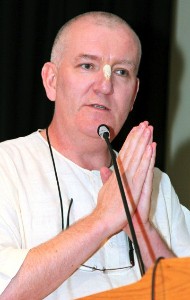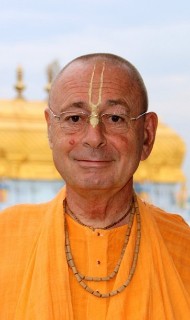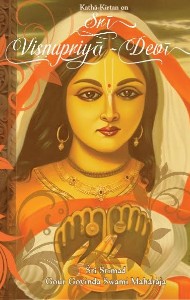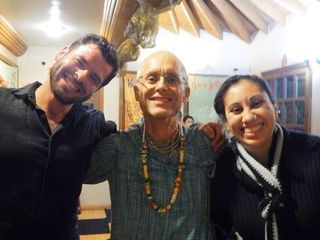
ISKCON Auckland New Zealand: Krishna Holi Festival 2016 (Album with photos)
Kalasamvara Das: Today thousands of guests turn up for a wonderful and colourful day at our annual Holi festival.
Find them here: https://goo.gl/TBVA1c
Websites from the ISKCON Universe

ISKCON Auckland New Zealand: Krishna Holi Festival 2016 (Album with photos)
Kalasamvara Das: Today thousands of guests turn up for a wonderful and colourful day at our annual Holi festival.
Find them here: https://goo.gl/TBVA1c

Choosing to be a part of God’s life.
Ananda Devi Dasi: Every year a group of yoga students from America go to the gardens of a flower grower in Vrindavan (India), who produces large amounts of flowers for the garlands and decorations in the many temples there. This year, however, the gardens did not have much to show. Weather and other factors had wiped out the crop and the gardener, already poor by our standards, was even poorer. As they sat with him he was jovial, telling them stories of Krishna and his temple experiences. ‘How can you be so happy after so much loss?” they asked him. “That part of my life is a struggle, and this year will be hard,” he said. “But my relationship with Krishna has nothing to do with that. That’s always joyful.” Here, I thought, is wisdom in action. Rather than making God a part of his life (and struggle) he was choosing to be a part of God’s life. In other words, as we move along in the world, dealing with the ups and downs, we often lean on God, pray for help, find Him in our little universe, and even complain when we don’t think He is doing his part (i.e., fulfilling our desires). There is nothing wrong with this, and it’s better than not acknowledging His existence at all. Krishna is happy to help and be involved, as he was with Arjuna in the Gita’s battlefield. Yet as students of the science of bhakti yoga we learn that the true goal is to get to know Krishna who exists beyond our mundane life. If Krishna is a person, then He has a life, a place, and all kinds of relationships. The gardener gives us a clue. Instead of pulling God into our own little life, why not set that aside for a while, and start looking into God’s life? Talking time everyday to be in a relationship that has nothing to do with the karma of the world, nothing to do with who we are in this body, nothing to do with the present context of our life – that’s what the gardener was doing. Yes, I lost everything this year, he said, but not Krishna. He is always there. And that’s my joy. Let that be our joy too.

Iskcon Sydney: Workshop with HG Mahatma Das (Album with photos)
“Building Community together”
Srila Prabhupada: Devotee means very liberal and kind to everyone, always gentleman under all kinds of conditions of life. Letter to Hamsaduta, December 10, 1972.
Find them here: https://goo.gl/hvdEk1

Radhanath Swami: When I was young, no one called it Valentines Day, everyone called it Saint Valentine's day. You remember? Now they just call it Valentines Day because they don’t want to think about saints (laughter). Because it’s actually totally contradictory to the whole conception of what valentine’s day is all about. Who was saint valentine?

Avoiding Yamaraja: Ajamila’s story. Ajamila’s story is given in the Bhagavata Purana (6th book, chapter 1) as an example to illustrate that even the most wicked person can attain salvation. Ajamila was a brahmana who was once sent by his father to the jungle to fetch leaves and twigs to make the sacrificial fire. Ajamila met there a beautiful sudra woman. Forgetting everything, the brahmana made her his wife and children were born to them. When that brahmana, who was the very embodiment of all vices, reached the age of eighty-seven, the time came for him to die. Yamadutas (agents of Yama, the god of death) had arrived. The frightened Ajamila shouted loudly the name of his eldest son, “Narayana”. Hearing the repeated call of his name “Narayana”, servants of Visnu appeared there and dismissed the agents of Yama. From that day Ajamila became a devotee of Vishnu and did penance on the bank of the Ganges and after some years attained salvation. Ajamila was saved from hell because he chanted “Narayana” as the Yamadutas approached him. Afterwards Yamaraja forbade his servants from touching devotees who “even if by mistake or because of bewilderment or illusion… sometimes commit sinful acts,” because “they are protected from sinful reactions because they always chant the Hare Krishna mantra.” Yamaraja then told the Yamadutas: “Paramahamsas are exalted persons who have no taste for material enjoyment and who drink the honey of the Lord’s lotus feet. My dear servants, bring to me for punishment only persons who are averse to the taste of that honey, who do not associate with paramahamsas and who are attached to family life and worldly enjoyment, which form the path to hell. "My dear servants, please bring to me only those sinful persons who do not use their tongues to chant the holy name and qualities of Krishna, whose hearts do not remember the lotus feet of Krishna even once, and whose heads do not bow down even once before Lord Krishna. Send me those who do not perform their duties toward Vishnu, which are the only duties in human life. Please bring me all such fools and rascals.”

Oneness with God, Different from God, or both?
Urmila Devi Dasi: OBL Kapoor, godbrother of Srila Prabhupada, explains how the various sampradayas view simultaneous oneness with, and difference from, God, in this chapter of his well-known book. Srila Prabhupada especially liked this book and wanted ISKCON centers to distribute it. This chapter makes the concepts of oneness and difference very clear and as understandable as anything “inconceivable” can ever be!
This chapter is helpful for those are practitioners of bhakti-yoga, for those who teach bhakti, for scholars, and anyone who is spiritually curious.
To read the entire article click here: http://goo.gl/Ot0iQe

We are looking for pujaris/cooks to serve the Deities here in Berkeley temple. The Deities here include Lord Jagannatha, Baladeva and Subhadra who were installed by Srila Prabhupada in 1967. Hence, these are the first Deities in ISKCON.
Anyone interested should contact us by calling 707-426-4672.
Your servant,
Jagannath Swami dasa
Temple President
ISKCON
2334 Stuart St
Berkeley CA 94705
Corporate or Family ISKCON?
It’s always nice to receive e-mails which are from devotees, especially when in work however recently one or two appear to have dark undertones; almost a play for why the reasons that attracted me to ISKCON are unrealistic and a thing of the past.
The opening statement gave me a feeling of impending doom, may be it’s time to leave ISKCON as this new improved corporate; boiling the milk ISKCON which appears to have little to do with my spiritual well-being or advancement. And more to do with how to get as much money out of me and make the whole experience one of sheer misery, a one size fits all, your only a devotee if you do this or that course repulses me and my only response run away.
You see when I first met the devotees their was a family feeling, it was like I had met old friends within a short time my thoughts were how to get to spend more time with them. They tolerated a lot, never asked me for laxmi (Well apart from books, and that was alright, given they were so enthusiastic I read them I became enthusiastic to read)
This family atmosphere this friendship based on loving care for one another, getting to know the individual and developing them at a pace and way that developed trust; eventually one wanted to reciprocate this love and the devotees had you hooked on devotional service. No course, no money just love.
With this simple exchange one became hooked on Japa, reading, sharing and doing some small service; the desire to do more of these increasing the more you had this association, and this is what a lot of individuals speak about, the loving care a feeling of being a part of something, the feeling of family the feeling of love.
What the devotees had shown me was simple and in many ways these loving exchanges meant that you would do almost anything for them, it’s simply something that cannot be learnt in any educational setting, no classroom could teach devotional service in it’s purest form.
Devotional service comes from a basis of love, love comes from being cared and feeling cared for; so the term family appears appropriate as this is the nearest approximation or way of expressing a feeling felt when coming into devotee association.
Personally I miss those early days, this new corporate impersonal ISKCON is choking the life out of me, mentorship was by the devotees leading by example and recommendation was by a senior disciple; now mentorship is tor-mentorship and appears a way to fleece money out of the individual and little of engagement in devotional service, do this course, do that course give us money.
Over the years my inspiration has been a few devotees who by example and loving time spent in association makes ones desire increase, that one wants to do more. Simply put friendship.
I’ve learnt more in discussions with these devotee friends questioning and being questioned, and when one comes across something that appears contradictory one does research studying of Srila Prabhupada’s books and then sharing what has been learnt. Thus real knowledge increases and as it’s personal and not learnt in an educational setting it’s personal one remembers.
The email was explaining how now ISKCON is too big for this, temple presidents cannot get to know those who attend, and the family atmosphere one used to talk about is impractical and not work, one cannot expect recommendation to be as in the early days and spoken about by Srila Prabhupad, we now have a new structure.
The new structure means courses, exams, forms; a committee who decide upon ones suitability not on real knowledge of the individual but how all these look, even the recommendation of the mentor can be overruled by a committee member who has had little association with the candidate; now this is impersonal by any standard and far from the system recommended by Srila Prabhupad’s who wanted initiation recommendation from a senior devotee who actually knew the aspiring devotee, this loving care some describe as family some like me describe as friend. This real knowledge of the aspiring devotee cannot be learnt in a classroom.
Yes temples have grown.
Yes it’s impractical for one individual to know everyone that attends our larger temple.
Yes learning about devotional life is good
Yes studying Srila Prabhupad’s books are good.
But an artificial mentorship system and an artificial impersonal committee, a corporate ISKCON one were the feeling of friendship and family is frowned on; seriously?
My conclusion is this is best avoided by one who wishes to make any real spiritual advancement, and a plea to all those in management and GBC please get rid of this nonsense and return to what Srila Prabhupada showed us, real love and personalise our approach that inspires one to spontaneously increase our desire to increase in devotional activities.
Or may be it’s that ISKCON doesn’t want individual’s like me who don’t need classrooms and form’s to be inspired, just the association of amazing devotees who make you feel like a part of something special; and inspire you to do more service and because your inspired that naturally inspires others.
But my fear is corporate ISKCON rather than personal ISKCON is the one that is winning the day.
And I’m guessing those who see corporate ISKCON as the way forward will use this article not to learn how others function and how to inspire a different group in devotional life, but will simply go look told you so he’s anti-ISKCON, and simply miss the point altogther.
Friendship first and all other things will come in time.
Krishna’s words in chapter three are extremely pertinent to this important debate. Here in this video, Vraja reads from and explains his book, A Simple Gita – which is available at www.vrajakishor.com
 By the Sastric Advisory Committee
By the Sastric Advisory Committee One argument for a beardless deity of Advaita Acarya is that we should follow Srila Bhaktisiddhanta Sarasvati Thakura. Certainly we should follow the previous acaryas. Sometimes, as in the case of Maharaja Priyavrata, the param-guru may override the decision of the guru. In this regard, Srila Prabhupada wrote, “The duty of a great devotee is to carry out the order of the spiritual master, or the spiritual master of the spiritual master in the parampara system. “ (SB 5.1.20 purport) Unfortunately, neither Srila Prabhupada nor his Guru Maharaja is physically present with us. Srila Prabhupada also wrote, “In the Skanda Purana it is advised that a devotee follow the past acaryas and saintly persons, because by such following one can achieve the desired results, with no chance of lamenting or being baffled in his progress.” (NOD Ch. 7) Continue reading "The Sastric Advisory Committee’s paper on Sri Advaita Acarya’s Deity
→ Dandavats"
 By Giriraj Swami
By Giriraj Swami Advaita Acarya, although Visnu Himself, was in the mood of a Vaisnava. As a Vaisnava, He felt compassion for the fallen conditioned souls who were suffering without Krsna consciousness. Although previously Navadvipa had been a great center of devotion, it had deteriorated into a center of dry learning. Thus, Advaita Acarya felt compassion for the fallen souls of the age, so engrossed in material affairs, devoid of devotional service to Krsna. In the mood of a humble Vaisnava, although He was Visnu Himself, He felt that He was not capable of delivering the fallen souls. He believed that only Sri Caitanya Mahaprabhu Himself could preach the yuga-dharma of hari-nama-sankirtana and deliver them. Advaita Acarya Prabhu was an ideal householder. He had read in the scriptures that the Lord sells Himself to a devotee who offers Him a Tulasi leaf and a palmful of water. As a grhastha brahmana, He worshipped a salagrama-sila at home. Therefore, He specifically began to worship Salagrama with Ganges water and Tulasi leaves with the aim of bringing about Sri Caitanya Mahaprabhu's descent. Continue reading "The appearance day of Sri Advaita Acarya
→ Dandavats"
HG Bhakti Vijnana Goswami – SB 11.2.2 – 5.02.2016

February 14. ISKCON 50 – S.Prabhupada Daily Meditations.
Satsvarupa dasa Goswami: Prabhupada Is Not Ordinary.
The sastras warn us not to think of the spiritual master as an ordinary man. That is very hard for the nondevotees to comprehend. They think the spiritual master is an ordinary person because they see him growing old, or they see him show anger. They misjudge him in many ways. They have no idea what is ordinary and what is extraordinary. It takes spiritual vision to appreciate the pure devotee, but the sastras tell us the truth.
The sastras list certain qualifications of a spiritual master, yet even among those who possess these qualifications, Srila Prabhupada is extraordinary. What is it about him that makes him extraordinary? Or, we can ask, “There appear to be some extraordinary things about Prabhupada, so what is it about Prabhupada that makes these things extraordinary?”
Dr. Harvey Cox said, “Prabhupada is one in a million.” He founded the Hare Krishna Movement, which continues to grow and establish roots in countries all over the world. Fulfilling Lord Caitanya’s prediction that the holy name would be known in every town and village of the world was seen as a near impossible task by other sannyasis. Prabhupada fulfilled the Lord’s prediction. He must be an extraordinary person, someone fully empowered by Krishna, to possess so much pure devotion and determination.
One should not see the spiritual master as an ordinary man. This is not only the proper etiquette described in the Vedas, it is reality. The spiritual master is never ordinary, even if he appears to be growing older, or seems to forget a Sanskrit verse, the disciple should never doubt his spiritual master because of these things. Prabhupada explained that his perfection was that he was always preaching and was fully engaged in Krishna consciousness. The guru is not the Supersoul who knows all things, but he has an intimate relationship with the Supersoul. Srila Prabhupada was always dedicated to Krishna’s mission. He produced amazing, tangible results. He is extremely dear to Krishna. All his displays of anger, or illness, or humanness are transcendental; they are meant to bring us closer to him in loving exchange.
To read the entire article click here: http://www.dandavats.com/?p=20490&page=5
SATURDAY NIGHT HARINAM; London (6-02-2016)
RAIN AND STRONG WINDS… said the weather forecast
Still there was a great turnout of devotees and the Harinam was…
special again. So many nice things happened.
One devotee handed out prasadam to 5-6 police officers, one after the other, all in a row, while we were in Leicester Square. A little later on as we left the Square and moved off towards Piccadilly Circus, one policeman was seen playfully dancing, kicking his legs high into the air.
Over the past 4/5 weeks three young students all doing their GCSE’s this year have been coming down from Archway (North London) and enthusiastically joining in with the Harinams. This week they got soaking from the quite heavy rain, but the enthusiasm was not dampened one iota. They all have copies of Bhagavad-Gita and are happily reading them.
Also in recent weeks there have been two sisters (Deena & Diane) attending regularly. They are always happy to help hand out “On Chanting” Booklets and prasadam. This week I had a little chat with them and was really impressed to hear that they have been taking the day return train from Nottingham each week all the way to London specifically to attend the Samkirtan Parties. They came in contact with Krsna Consciousness through a Hare Krsna Festival programme held in Nottingham not long ago.
**************************************************************************
“So we are sending our men for street saṅkīrtana. It doesn’t matter whether people are eager to hear it or not, but it is auspicious. It will create an atmosphere which is very, very congenial to the human society. That should be our principle.
Srila Prabhupada 6th April 1973 New York.
800 pieces of prasadam and 1,500 On Chanting Booklets
We hope you enjoy this weeks video.
KINDLY SHARE IT WITH YOUR FRIENDS
Param Vijayate – Sri Krsna Samkirtanam
All Glories to Srila Prabhupada
Gita verse-by-verse study Podcast
Download by “right-click and save content”
The post Gita 09.22 – Seek spiritual security not just in the soul but in Krishna appeared first on The Spiritual Scientist.
 By Praghosa Dasa
By Praghosa Dasa “A pure Vaisnava should be very careful to engage in his specific duty without criticizing others. This is the safest position. Otherwise, if one tends to criticize others, he may commit the great offence of criticizing a Vaisnava” In the pastime of Jagai and Madhai, prior to them receiving the mercy of Lord Caitanya, they were glorified as having one good quality. The fact that they kept such bad association meant that they had never come into contact with devotees hence their good quality was that they had never committed vaisnava aparadha. There are so many references in sastra as to the importance of avoiding offending vaisnavas, so as I read the words of Daksa it seemed worthwhile to look a little deeper into why he would offend Narada in this way. On the face of it Daksa was extremely upset because his first 10,000 sons, the Haryasvas, whom he had earmarked to populate the planet with good progeny, were convinced by Narada to by-pass the grhastha asrama. Due to the inherent risks of being side tracked by maya while populating the world, Narada suggested they would be better to simply devote themselves exclusively to the path of renunciation. That was bad enough but then Daksa had another 1,000 sons to do the job his previous sons had been diverted away from but Narada had a different idea and did exactly the same again, convincing Daksa’s latest arrivals to follow in the footsteps of their elder brothers. Continue reading "Accepting our Lot, Gracefully
→ Dandavats"
 By Sivarama Swami
By Sivarama Swami Suddha-bhakti-cintamani deals with the subject of steadiness from several different perspectives. What does real steadiness mean? nasta-prayesv abhadresu nityam bhagavata-sevaya: “nasta-prayesu,” when almost all the inauspicious things in the heart, which are of so many variations, when they are more or less eradicated then there is steadiness. And this “more or less,” Srila Prabhupada said “75%,” so when 75% of impurities in the heart are eradicated, then the devotee achieves a certain level of spiritual steadiness that enables him to think about Krishna, to chant Krishna’s names, because his mind and senses are no longer distracted from chanting, serving, and thinking of Krishna. Why? Because the effect of the anarthas still remaining in the heart is minimal when compared to the storehouse of devotional energy that the devotee has acquired. Continue reading "Steadiness
→ Dandavats"

Festival of India set to debut in Nigeria.
TVC E, LIFESTYLE – India is one of the most religiously diverse nations in the world, with some deeply religious societies and cultures.
The artistry and culture of the Indians is set to manifest in Nigeria at the first ever Festival of India, a celebration of cultural unity and diversity.
The international society for Krishna consciousness West Africa in partnership with the indian diaspora made the announcement in Lagos.
The Festival of India also called Rath Yaatra festival originated in the holy city of Puri, India and has been celebrated for thousands of years.
Organizers say, bringing the festival to Nigeria is to project the country in positive light.
The festival would include a display of various Indian costumes, dressing and dance groups representing different states in India.
Source: http://goo.gl/2XlPuz

Saturday Night Harinam London 6-02-2016 (11 min video)
RAIN AND STRONG WINDS… said the weather forecast. Still there was a great turnout of devotees and the Harinam was… special again. So many nice things happened. One devotee handed out prasadam to 5-6 police officers, one after the other, all in a row, while we were in Leicester Square. A little later on as we left the Square and moved off towards Piccadilly Circus, one policeman was seen playfully dancing, kicking his legs high into the air. Over the past 4/5 weeks three young students all doing their GCSE’s this year have been coming down from Archway (North London) and enthusiastically joining in with the Harinams. This week they got soaking from the quite heavy rain, but the enthusiasm was not dampened one iota. They all have copies of Bhagavad-Gita and are happily reading them. Also in recent weeks there have been two sisters (Deena & Diane) attending regularly. They are always happy to help hand out “On Chanting” booklets and prasadam. This week I had a little chat with them and was really impressed to hear that they have been taking the day return train from Nottingham each week all the way to London specifically to attend the Samkirtan Parties. They came in contact with Krsna Consciousness through a Hare Krsna Festival programme held in Nottingham not long ago.
*******
“So we are sending our men for street sankirtana. It doesn’t matter whether people are eager to hear it or not, but it is auspicious. It will create an atmosphere which is very, very congenial to the human society. That should be our principle.” Srila Prabhupada 6th April 1973 New York.
Watch it here: https://goo.gl/Cx1euW
800 pieces of prasadam and 1,500 On Chanting Booklets.
Ys
Bhajahari das Adhikary

Travel Adventures of a Krishna Monk.
Diary of a Traveling Sadhaka by Krishna-kripa das - New York City Harinam, Albany. (Sent from Gainesville, Florida, on February 12, 2016)
I rejoined the New York City Harinam party for the second half of December, except for a one-day excursion to see my family in Albany for Christmas Eve. Because of the cold, our NYC Harinam party sang in the subway stations except for a couple days in Union Square and one night in Times Square. New Years Eve was special in that I did harinama with the NYC Harinam party at the subway stations at Times Square and Grand Central, and outside at Bryant Park, and with the Bhakti Center devotees all the way from the Bhakti Center, in the Lower East Side of Manhattan, over the Manhattan Bridge, to Radha-Govinda Mandir in Brooklyn.
To read the entire article click here: http://goo.gl/gXdjpL

Garuda and Yamaraja.
“Our friends, relatives and so-called wives and children are not only fallible, but also bewildered by the outward glamor of material existence. As such, they cannot save us. Still we think that we are safe within the orbit of family, society or country.” One who properly prepares for the time of death is really intelligent, while one who thinks he can remain at home forever and enjoy the association of his wife and children is a fool. In illusion a man thinks, “My bank balance, my nice house, and my family will protect me.” But these cannot protect anyone. In this regard we came across following thought provoking story.
High in the reaches of Mount Kailash is the abode of Lord Shiva. One evening Lord Vishnu, came to see Lord Shiva. He left behind at the entrance Garuda, who served as His vehicle. Garuda sat alone, marveling at the natural splendor of the place. Suddenly his eyes fell on a beautiful creature, a little bird seated on the arch crowning the entrance to Lord Shiva’s place. Garuda wondered aloud, “How marvelous is this creation! One who has created these lofty mountains has also made this tiny bird – and both seem equally wonderful.” Just then Yamaraj came passing by with the intention of meeting Lord Shiva. As he crossed the arch, his eyes went over to the bird and he raised his brows in a quizzical expression. Then he took his eyes off the bird and disappeared inside. Even a slight glance of Yamaraj is said to be the harbinger of death. So Garuda told himself, “Yamaraj looking intently at the bird can mean only one thing – the bird’s time is up. Perhaps on his way back he will carry away the bird’s soul with him.” Garuda’s heart was filled with pity for the helpless creature. That it was oblivious of its own impending doom further agonized Garuda and he resolved to save the bird from the clutches of death. He swooped it up in his mighty talons, rushed to a forest thousands of miles away and left the bird on a rock beside a brook. Then he returned to Kailash and regained his position at the entrance gate. Soon after, Yamaraj emerged from inside, and nodded to Garuda in recognition. Garuda greeted him and said, “While going in, you saw a bird and for a moment you became pensive, why?” Yamaraj replied, “Well, when my eyes fell on the little bird, I saw that it was to die in a few minutes, swallowed by a python, far away from here in a forest near a brook. I wondered how this tiny creature would traverse the thousand of miles separating it from its destiny in such a short time. But there are no such serpents here, high on Kailash, and I was briefly puzzled. Then I forgot. Surely it must have happened somehow.” Saying this, Yamaraj smiled and went away. This story nicely explains us however we hard we try to escape from death, “Death is inevitable”. Death in the form of time, kala, will seize us just like the serpent seizes its prey. Srila Sukadeva Goswami is advising us that understanding the temporary nature of material existence, we must utilize our time for the self-realisation. When we fail to do this we will remain bewildered in this material existence, life after life. When we use our time for Krishna, death is also blissful as after death we will again go back to Krishna.
The post Who is a Vraja-vasi? appeared first on SivaramaSwami.com.

Hare Krishna! Please accept our humble obeisances! __^_o

Puri Retreat (Album with photos)
Deena Bandhu Das: Visiting Baligram, the sweet rural village of Dasya Bauri, a famous out caste devotee of Jagannatha! Then we visited Haridas Thakura’s Samadhi and many important places on Satasana Marg nearby! The Seven Rishis have their asans there. Finally ending the retreat with katha and kirtan.
Find them here: https://goo.gl/RgiWhi
The post Daily Darshan : February 13th, 2016 appeared first on Mayapur.com.
 By Gour Govinda Swami
By Gour Govinda Swami When Mahaprabhu left home, His servant Isana Thakura took care of Sacimata and Vishnupriya. Vamsivadana Thakura who was very dear to Mahaprabhu also always stayed with Vishnupriya and Sacimata. He received so much krpa, mercy, from Sacimata and Vishnupriya, especially from Vishnupriya Thakurani. Vamsivadana Thakura has written one song, which is Viraha Sangita, a song of separation. The beginning line is ara na heriba sonara kamale nayana khanjana naca. When Srinivasa Acarya came to Mayapura, Isana Thakura was an old man at that time. He took Srinivasa Acarya to Vishnupriya and introduced him to Her. Vamsivadana Thakura had also showered his mercy on Srinivasa Acarya. Continue reading "Sri Vishnupriya
→ Dandavats"

ISKCON Purchases 50 Acres Near Downtown Columbus.
ISKCON of Columbus, Ohio, USA, has purchased fifty acres of prime real estate fifteen minutes’ drive from downtown Columbus. On the land, which they have offered to Srila Prabhupada for ISKCON’s 50th anniversary, devotees plan to develop a Krishna conscious community that offers the best of both urban and rural worlds. The local congregation raised $500,000 and bought the new property outright. Located in a fast-developing suburb called Hilliard, it’s flanked by upcoming million-dollar homes and neighboring land owned by banks. While all amenities are close by, ISKCON Columbus is planning a haven of simple living and high thinking. Within six months to a year, devotees expect to break ground and begin construction on a gorgeous temple with a 500-person capacity temple room, a gift shop, accommodation for celibate students, and a children’s school.
To read the entire article click here: http://goo.gl/Iai8qY

February 13. ISKCON 50 – S.Prabhupada Daily Meditations.
Satsvarupa dasa Goswami: Talk to Srila Prabhupada.
I have been going too long without trying to talk to Prabhupada. We shouldn’t refrain from talking to Prabhupada out of lack of faith. If a Christian can talk to Christ, and a yogi can talk to his Supersoul, why can’t a Prabhupadanuga speak his mind to Prabhupada? It just takes faith and hope that he will hear us – hope that Krishna will hear us. We may say, “Well, I definitely have faith in Krishna as the Supersoul,” but that faith may be more an acceptance of the scripture, than direct realization of the Lord in the heart. But the same scriptures tell us that the pure devotee, by Krishna’s grace, can be just as present as the Supersoul in the heart of His disciple. We do not have to doubt that, even if we don’t have direct realization of it. If we do doubt it, then we have to pin our hopes on a prayer to both Krishna and Prabhupada, “Please, Krishna, deliver my message to Prabhupada. Please, Prabhupada, deliver my message to Krishna. Please, Srimati Radharani, forgive me for my offenses, and let me become a devotee of my spiritual master, Lord Krishna, and You.”
To read the entire article click here: http://www.dandavats.com/?p=20490&page=5
07.02.2016 H.H.Badrinarayan Swami_SB06.05.14

Sunday Love Feast for All | ||||||||||||||||||
| ||||||||||||||||||
| ||||||||||||||||||

Visiting the temple in Tijuana, meeting and talking with the devotees, having the opportunity to speak, and participating in the kirtan, was a huge inspiration for me, and a super powerful way to begin my speaking tour on the West Coast. Facing death head on and joyfully embracing the possibility of having only a short time left in my body has been greatly beneficial to my life, like a lightning bolt of devotional and practical energy and guidance. Concerned friends ask me how I am doing, and my answer is “fine,” which means normal. Other than my cancer protocols, it is difficult to know that my body must be quite out of balance to have attracted cancer.
As it is said in the alternative treatment universe, I am not sick because I have cancer, but I have cancer because I am sick—which means a compromised immune system. However long I may live, I am taking the worst case scenario seriously and doing everything I can to strengthening the immune system and send the cancer cells elsewhere. At the same time, I am putting aside self-doubt, and embarking on speaking tours to share my realizations on the benefit of facing death so we can fulfill our personal mission, and practice what I think of as “essential spirituality.” I have also increased my writing schedule for producing a number of books. All in all it has been an incredible journey and is very exciting and enlivening—and this is only the beginning!
After 7 nights and 5 days of treatment at the clinic, I moved on to the next part of my journey. I scheduled speaking engagements at a devotee’s home program in San Diego, and temples in Los Angeles, and Silicon Valley.
Gita verse-by-verse study Podcast
Download by “right-click and save content”
The post Gita 09.21 – Blindness to mortality, even if it be in heaven, is still blindness appeared first on The Spiritual Scientist.
(Kadamba Kanana Swami, November 2015, Vrindavan, India, Video Interview)
The real meaning of love means to act fully for the pleasure of Krsna and all living beings – to totally dedicate ourselves to Krsna’s well-being and to the well-being of all living beings in Krsna’s creation. This is the real meaning of love.
Income and Expenses for 2015
Category Amount
Book Sales 67.31
Donations 3,796.15
Loans 8.16
Total Income $3,871.62
Category Amount
Book Purchases 13.60
Festival Fees 54.21
Gifts 377.09
Health 74.22
Electronics 3.64
Maintenance 49.07
Prasadam (Food) 53.67
Travel 3,347.22
Total Expenses $3,972.72
Balance -$101.10
ei ta’ svabhava tanra agraha kariya
piche ninda kare, age bahuta khaoyaña
“The characteristic of Ramacandra Puri was that first he would induce someone to eat more than necessary and then he would criticize him.”
purve yabe madhavendra karena antardhana
ramacandra-puri tabe aila tanra sthana
“Formerly, when Madhavendra Puri was at the last stage of his life, Ramacandra Puri came to where he was staying.”
puri-gosañi kare krsna-nama-sankirtana
‘mathura na painu’ bali’ karena krandana
“Madhavendra Puri was chanting the holy name of Krsna, and sometimes he would cry, “O my Lord, I did not get shelter at Mathura.”
ramacandra-puri tabe upadese tanre
sisya haña guruke kahe, bhaya nahi kare
“Then Ramacandra Puri was so foolish that he fearlessly dared to instruct his spiritual master.” (Cc Antya 8.17 -20)
Giriraj Swami: “This also demonstrates the principle—yasya prasadad bhagavat-prasado yasyaprasadan na gatih kuto ‘pi, that by the mercy of the spiritual master one gets the mercy of Krishna but by displeasing the spiritual master or somehow being bereft of the mercy of the spiritual master one has no standing in devotional service.”
Kirtan, Alachua
Lessons from Sri Madhavendra Puri’s Last Days, Alachua

Great MANTRA for LOVE and PEACE! (3 min video)
A compilation of friendly people on the streets of London chanting the maha-mantra and contributing to the peace of the world. Very happy and nicely edited video.
Watch it here: https://goo.gl/AMtgoE
2016 Parikrama. https://flic.kr/s/aHskuosHrE
The post Scenes from Vrndavana parikrama and Javat and Ter-kadamba on Vasant-pancami appeared first on SivaramaSwami.com.